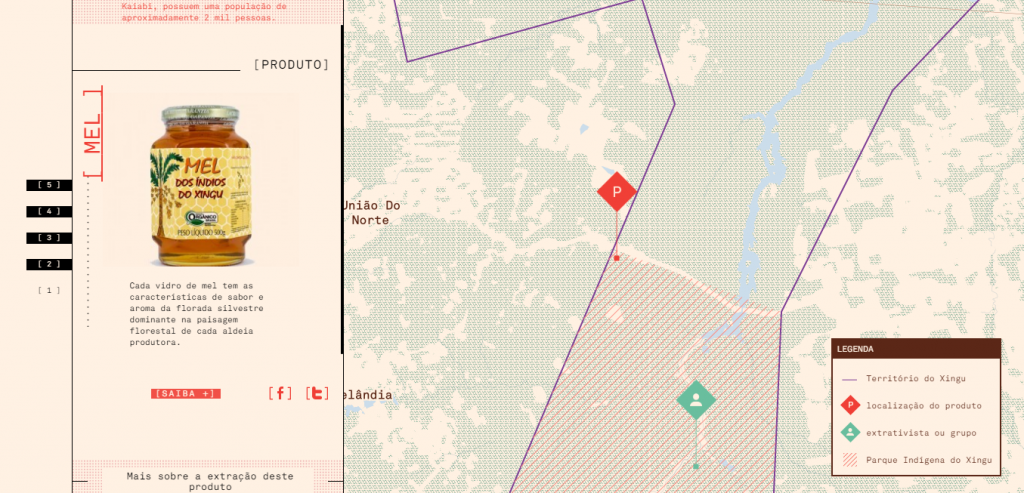By Iván Ulchur-Rota
Ciunipa Kayaba is a member of the Kawaiweté community –one of many indigenous groups that inhabit the Xingu territory, in the south of the Brazilian Amazon. He is also one of the producers of honey Dos Indios Do Xingu, which is extracted from that same area. I know this from browsing through the website of Origens Brasil, a project that aims at using cutting-edge technology to connect buyers to high quality products from the Xingu corridor. It’s a move beyond certification: a unique label that shows the full story of the production process. Find honey and you learn that this particular mel started as a brand in 2001, that it was the first indigenous product in Brazil to receive a federal inspection certificate, and that its uniquely floral taste depends on the preservation of its natural surroundings. More importantly: you get to see what’s happening in its place of origin.
The Xingu territory in Brazil, situated along the Xingu River in the Amazon, is quite iconic. It spans over 26 million hectares and is inhabited by 17,000 indigenous people who speak many different languages. Since 1975 tribes from the northern territories of the Xingu have been fighting against the construction of the Belo Monte dam, a vast wall of stone, steel and concrete described by The Guardian as “something out of Mordor”. Now the 5km-wide dam closes the northern part of the Xingu river, while illegal logging and mining continue to pose a threat to the culture and livelihood of many local communities south of the dam. But they are still organized and resisting: the lush biodiversity of these territories allows them to make a living by extracting and distributing sustainable, wild-harvested products. Now imagine the challenge that entails: to get buyers that understand the value of these products in order to preserve the forest together. Not easy, sure. But doable?
The stories behind these natural products are often invisible. That is why for Patrica Cota Gomes, “the Brazilian market has yet to recognize the value of these type of products”. Patricia coordinates the Origens project for Imaflora, a Brazilian non-profit certifier that aims to promote agricultural and forestry transformations. Over Skype she sounds excited and inspired by what Origens could accomplish. “You can think of it as a new tool for transparency”. By sharing screens, Patricia walked me through the concept behind Origens with a thorough and lively presentation. “It not only provides information about each product. The tool is about traceability and impact analysis.” In that sense, Origens Brasil could slowly be getting rid of the certification middleman. No need for expensive labels. Want certified products? Look at the maps on the site!
Though the site is relatively easy to navigate for non-Portuguese speakers, some familiarity with at least a Romance language is recommended. As a whole, the design is visually didactic and explicative. A satellite image next to each product maps out any noticeable changes in forest cover around the area where each product comes from –its origins. The Brazil nut Castanha Do Brasil is, for instance, produced at the northeastern part of the Kayapo Indigenous territory. Two pins on the map indicate the location of the product’s extraction and the area where its producers live. In this case, there is tons of green around both points. Right under the picture of Nhakangroti Kayapó, one of the producers, Origens ratifies: “The work of this Kayapo member of Origens Brasil helps protect the diversity of Xingu.”
This new initiative could become a viable alternative to certifications as we know them: to certify by letting communities tell their stories, adding value to their work and products while also generating information that’s directly useful to them. Origens allows everyone –buyers, distributors, producers– to keep tabs on the supply chain.
According to Patricia, it’s been a slow process. “It took over three years to happen”, she told me. The platform is the result of a general consultation with all stakeholders along the supply chain, including local organizations and traditional indigenous communities. As Patricia explains, while Imaflora was in charged of the administrative aspects of the project, at the heart of it were Xingu’s own territorial governing committees and many companies interested in finding more effective mechanisms to trace and evaluate the ecological impact of each product.
“What are labels supposed to do, after all?”, Patricia asked as we were wrapping up. “They are supposed to guarantee certain production standards, like whether the extraction of the product has low or high impact on the environment”. But often the requirements to get those labels make them inaccessible. It’s a little different for Origens Brasil: for producers to qualify to be part of the label, they must come from within a protected area of high biodiversity and have an operational supply chain.
Origens Brasil processes and provides the certifying information almost in real time. It’s like the advice given to writing students: show don’t tell. And this project is an important effort to start showing the full picture.


